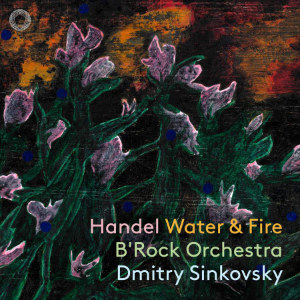
George Frideric Handel (1685-1759)
Water & Fire
Water Music Suites Nos. 1-3, HWV 348-350 (1717)
Music for the Royal Fireworks, HWV 351 (1749)
B’Rock Orchestra/Dmitry Sinkowsky
rec. live, April 2022, Muziekcentrum De Bijloke, Gent, Belgium
Pentatone PTC5187013 [65]
My first challenge is to overcome a prejudice against this recording occasioned by my distaste for the rather cheesy punning name chosen for this period orchestra , pronounced, apparently, “Be-Rock” – a joke which surely rather quickly wears thin, but let that go….
Neatly packaged in a slim cardboard slipcase, this is a live recording by a period orchestra of around fifty players, presenting two of Handel’s most popular and enduring works for orchestra, written at opposite ends of his career.
There are so many recordings that points of comparison can seem aleatory; however, I have narrowed them down to two recommended period versions in my collection: the Water Music by King’s Consort on Hyperion (review – here coupled with their Fireworks, too) and Zefiro’s Royal Fireworks on Arcana (review).
My first impressions on playing this was that the tempo of the Allegro opening of Suite No. 2 is too staccato and the sound rather underpowered – nor am I sure what the busy, scampering harpsichord adds. That reaction continued through to the “Alla hornpipe”, which is rushed and angular, with heavily accented dotted rhythms. Comparison of timings reveals that my response has less to do with duration – the numbers are often similar – and more with phrasing and resonance; the B’Rock sound is often hollow and whining, the unvarying blare and parp of the period horns wearing on the ear – and the occasional blip is inevitable, for all the players’ accomplishment. The King’s Consort has a much fuller sound without compromising its supposed “authenticity”. They, too employ a harpsichord but it is much more discreet and instead the links between movements are provided by a solo violin, which falls much more naturally and sweetly upon the ear; likewise the King’s Consort horns are much mellower and tonally varied. I find it hard to shake off the feeling that throughout their playing, there is something of a hole in the centre of the B’Rock ensemble’s sound; surely the transition from outdoor music to this more intimate, chamber music scale is hardly faithful to the original purpose and context of Handel’s scores? I am puzzled by some tempo changes, too; why, for example, is there a sudden rallentando about a minute into that opening Allegro? It kills the momentum and the King’s Consort do not do that. I like much more the gentle, pastoral menuet with recorders which follows and the two Rigaudons are lively – but there, the treatment and both the choices of instrument and the balances among them create the impression that this music could have been written a century or two earlier in the Tudor period rather than in the Baroque; it smacks of period overkill.
Anomalies continue: the opening beat of very bar in Lentement opening of No. 3 is so heavily leaned into that it emerges as grotesquely over-emphasised compared with the stately grace of the King’s Consort version. Such an approach does not compensate for the reduction in grandeur and heft this smaller-scale approach occasions. The playing as such of the B’Rock Orchestra is often highly skilful and attractive and the quieter movements respond most successfully to their treatment of it, but my reservations overall still apply.
My observations and reaction similarly apply to the Royal Fireworks music here. I find Zefiro’s rendering of it much more impressive without sounding the least soupy, overblown or “Romanticised”. The kettledrums of B’Rock’s Jan Huylebroek are agreeably prominent but their brass instruments are too recessed and reticent. Again, the neater, fleeter music, such as in the Bourrée, fares much better for obvious reasons and La Paix has a nice swing to it, but the woodwind – especially the bassoon – lacks the resonant buzz which underpins the Zefiro ensemble. The trumpets in La Réjouissance are nicely sonorous but the horns struggle a bit to achieve clean articulation of the semiquavers and the Menuets lumber somewhat.
Devotees of “extreme” period practice might well find this recording to their taste, but all in all, I look for more of a compromise between the quest for authenticity and the sensibilities of my modern ears.
Ralph Moore
Help us financially by purchasing from





















